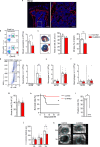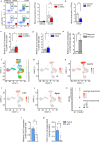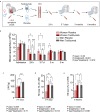Testosterone exacerbates neutrophilia and cardiac injury in myocardial infarction via actions in bone marrow
- PMID: 39910039
- PMCID: PMC11799197
- DOI: 10.1038/s41467-025-56217-x
Testosterone exacerbates neutrophilia and cardiac injury in myocardial infarction via actions in bone marrow
Abstract
Men develop larger infarct sizes than women after a myocardial infarction (MI), but the mechanism underlying this sex difference is unknown. Here, we demonstrated that blood neutrophil counts post-MI were higher in male than female mice. Castration-induced testosterone deficiency reduced blood neutrophil counts to the level in females and increased survival post-MI. These effects were mimicked by Osterix-directed ablation of the androgen receptor in bone marrow (BM). Mechanistically, androgens downregulated the leukocyte retention factor CXCL12 in BM stromal cells. Post-hoc analysis of clinical trial data showed that neutrophilia was greater in men than women after reperfusion of first-time ST-elevation MI, and tocilizumab, an interleukin-6 receptor inhibitor, reduced blood neutrophil counts and infarct size to a greater extent in men than women. Our work reveals a previously unknown mechanism connecting testosterone with neutrophilia and MI injury via BM and identifies the importance of considering sex when developing anti-inflammatory strategies to treat MI.
© 2025. The Author(s).
Conflict of interest statement
Competing interests: K.B. has received lecture fees from Amgen, AstraZeneca, Boehringer, Novartis, NovoNordisk, Pharmacosmos, Pfizer, and consultant fees from AstraZeneca, Boehringer, Pharmacosmos, and Pfizer. L.G. has received lecture fees from AstraZeneca, Boehringer Ingelheim, Novartis, and Amgen. The remaining authors declare no competing interests.
Figures





References
-
- Ng, V. G. et al. Impact of gender on infarct size, ST-segment resolution, myocardial blush and clinical outcomes after primary stenting for acute myocardial infarction: substudy from the EMERALD trial. Int. J. Cardiol.207, 269–276 (2016). - PubMed
-
- De Luca, G. et al. Relation of gender to infarct size in patients with ST-segment elevation myocardial infarction undergoing primary angioplasty. Am. J. Cardiol.111, 936–940 (2013). - PubMed
-
- Cavasin, M. A., Tao, Z., Menon, S. & Yang, X. P. Gender differences in cardiac function during early remodeling after acute myocardial infarction in mice. Life Sci.75, 2181–2192 (2004). - PubMed
MeSH terms
Substances
Grants and funding
LinkOut - more resources
Full Text Sources
Medical
Molecular Biology Databases
Research Materials

